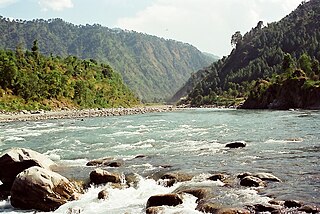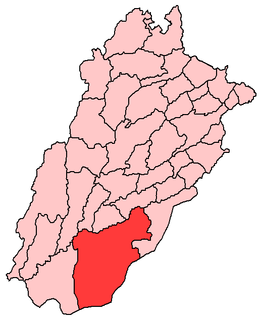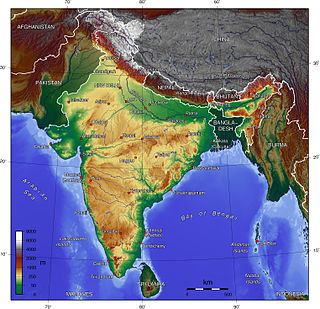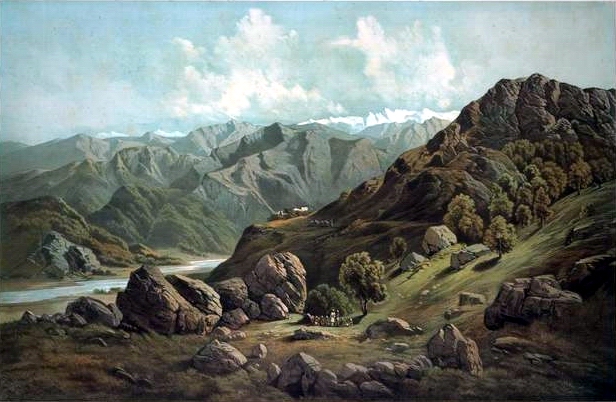
Sarasvati River was one of the Rigvedic rivers mentioned in the Rig Veda and later Vedic and post-Vedic texts. The Sarasvati River played an important role in Hinduism since Vedic Sanskrit. The first part of the Rig Veda is believed to have originated when the Vedic people lived on its banks, during the 2nd millennium BCE.

Ludhiana is a city and a municipal corporation in Ludhiana district in the Indian state of Punjab, and India's largest city north of Delhi, with an area of 310sq. km and an estimated population of 1,618,879 as of the 2011 census. The population increases substantially during the harvesting season due to the migration of labourers from highly populated states like Uttar Pradesh, Bihar, West Bengal and Odisha. The city stands on the Sutlej River's old bank, 13 kilometres (8.1 mi) south of its present course. It is an industrial center of northern India; the BBC has called it India's Manchester. Ludhiana was among the list of smart cities that will be developed by government of India. According to World Bank Group Ludhiana is the best city in India to do business.

Tashigang is a village near an ancient monastery in the state of Himachal Pradesh, India. It is the highest settlement in Spiti Valley, and is located in the Sutlej river valley near the India-Tibet border. National Highway 22 connects Khab with state capital Shimla. Below Tashigangis flows the Sutlej river, which originates from Mansarovar Lake in Tibet. The villages of Nako and Khab are nearby.

The Ravi River is a transboundary river crossing northwestern India and eastern Pakistan. It is one of six rivers of the Indus System in Punjab region. The waters of Raavi are allocated to India under Indus Water Treaty.

The Kingdom of Kuninda was an ancient central Himalayan kingdom documented from around the 2nd century BCE to the 3rd century, located in the modern state of Uttarakhand and southern areas of Himachal in northern India.

The Sutlej River (Punjabi: ਸਤਲੁਜ, Sanskrit: शतद्रुम, , is the longest of the five rivers that flow through the historic crossroads region of Punjab in northern India and Pakistan. The Sutlej River is also known as Satadree It is addressed as Shatarudra by the Gorkhalis. It is the easternmost tributary of the Indus River.

Bahawalpur District is one of the districts of Punjab, Pakistan. Its capital is the city of Bahawalpur. According to the 1998 Census of Pakistan it had a population of 2,433,091, of which 27.01% were urban. Bahawalpur district covers 24,830 km². Approximately two-thirds of the district (16,000 km²) is covered by the Cholistan Desert, which extends into the Thar Desert of India. The district is a major producer of cotton.

The Ghaggar-Hakra River is an intermittent, endorheic river in India and Pakistan that flows only during the monsoon season. The river is known as Ghaggar before the Ottu barrage and as the Hakra downstream of the barrage.

The state of Himachal Pradesh is spread over an area 55,673 km² and is bordered by Jammu and Kashmir on the north, Punjab on the southwest, Haryana on the south, Uttarakhand on the southeast and Tibet on the east. Himachal is a mountainous region, rich in its natural resources.

Baspa Valley is a river valley that is said to be named after the Baspa River. It lies in the Kinnaur District of Himachal Pradesh, India. Sangla is a major town in the Baspa Valley, and the valley is popularly known as the Sangla valley. Neighbouring villages include Chitkul, Karchham, Batseri and Kamru, old capital of Rampur Bashahr.
The initial entry point to Kullu Manali Circuit is from Chandigarh, India. Most of the stopovers and destinations lies on the National Highway No. 21. This highway originates from Chandigarh and ends at Manali. This path from Chandigarh to Manali followed by National Highway No 21. is the Kullu Manali Circuit. It is categorised into 4 main trails:-

Baspa River rises near the Indo-Tibetan border and forms the Baspa Valley - one of the most scenic in Himalayas. The Chung Sakhago Pass lies at the head of the valley. It is fed by the perennial glaciers and shares the catchment area with the Ganges.

The Indian Himalayan Region (IHR) is the section of the Himalayas within India, spanning 10 Indian states namely, Jammu & Kashmir, Himachal Pradesh, Uttarakhand, Sikkim, Arunachal Pradesh, Meghalaya, Nagaland, Manipur, Mizoram, Tripura, and hill regions of 2 states viz. Assam and West Bengal of Indian Republic. The region is responsible for providing water to a large part of the Indian subcontinent and contains various flora and fauna.

Khab is a small village in the state of Himachal Pradesh, India. It is located in the Sutlej river valley near the India-Tibet border. National Highway 5 connects Khab with state capital Shimla. Khab sangam is the confluence of Spiti river and Sutlej river. The Spiti river flowing through the spiti valley here meets the Sutlej, which originates from Mansarovar Lake in Tibet. The ancient monastery of Tashigang Gompa is nearby. The peak of Reo Purgil, which rises to 22,400 feet (6,800 m), is visible and the cold desert of Spiti lies across the nearby bridge.
Bara Culture was a culture that emerged in the eastern region of the Indus Valley Civilization around 2000 BCE. It developed in the doab between the Yamuna and Sutlej rivers, hemmed on its eastern periphery by the Shivalik ranges of the lower Himalayas. This territory corresponds to modern-day Punjab, Haryana and Western Uttar Pradesh in North India. Baran culture is believed to have initially developed independently of the Harappan culture branch of the Indus Valley Civilization from a pre-Harappan tradition, although the two cultures later intermingled in locations such as Kotla Nihang Khan & Bara, Punjab. In the conventional timeline demarcations of the Indus Valley Tradition, the Bara culture is usually placed in the Late Harappan period.

Sulemanki Headworks is a headworks on the River Sutlej near Okara, in the Punjab province of Pakistan.
Karachi–Peshawar Railway Line is one of four main railway lines in Pakistan, operated and maintained by Pakistan Railways. The line begins from Karachi City station or Kiamari station and ends at Peshawar Cantonment Station. The total length of this railway line is 1,687 kilometers (1,048 mi). There are 184 railway stations from Kiamari to Peshawar Cantonment on this line. The line serves as the main passenger and freight line of the country. 75% of the country’s cargo and passenger traffic uses the line. The line is currently undergoing an six-year ₨886.68 billion (US$8.4 billion) upgrade and renovation as part of the China Pakistan Economic Corridor, with average rail speeds expected be doubled to 160 kilometers per hour upon completion.

National Highway 505, commonly called NH 505 is a national highway in India. It is a spur road of National Highway 5. NH-505 traverses the state of Himachal Pradesh in India. NH505 a high altitude road, covers Kinnaur and Lahaul and Spiti districts of Himachal Pradesh, mainly running along Spity river in Spity valley. The highway from Kaza to Gramphu remains closed for nine months in a year due to heavy snowfall and closure of Kunzum La pass at an altitude of 4,550 m (14,930 ft).


















